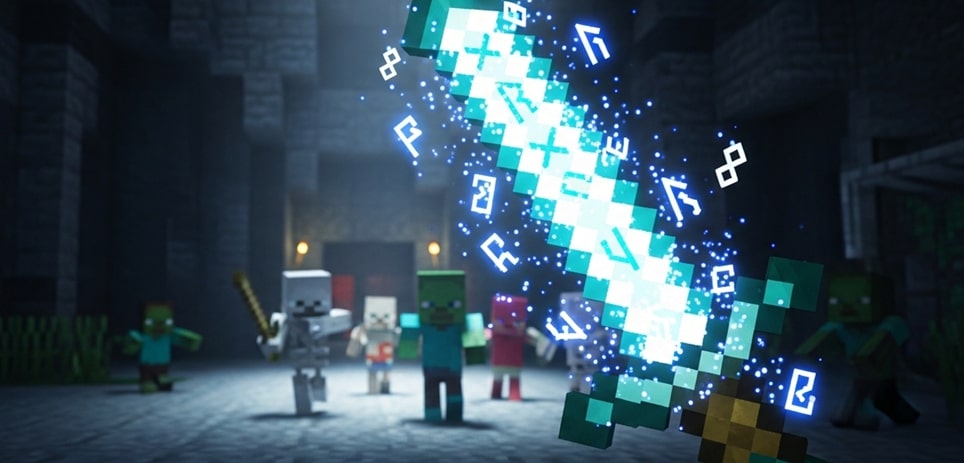
The Smite enchantment is a weapon enchantment that provides bonus damage specifically against undead mobs when applied to swords and axes. It does not affect living mobs or players. The enchantment is tiered from I through V, with each level adding a fixed amount of bonus damage against qualifying enemies.
At its core, Smite is a situational but powerful enchant: when used in the right scenarios (e.g., Wither fights, skeleton grinders, zombie farms) it dramatically reduces kill time and resource cost per mob drop. For players who farm undead mobs or intend to take on bosses classified as undead, Smite often outperforms generalist options.
Exact damage values and edition differences
Smite adds a fixed bonus of +2.5 damage (which equals 1.25 hearts) per enchantment level against undead mobs. That means:
- Smite I = +2.5 damage
- Smite II = +5.0 damage
- Smite III = +7.5 damage
- Smite IV = +10.0 damage
- Smite V = +12.5 damage
These numbers are used in damage calculations on both Java and Bedrock editions, but exact interplay with base weapon damage, critical hits, armor reduction, potion effects, and game edition mechanics can alter effective DPS in practice. Competitive guides and the Minecraft Wiki provide the authoritative breakdowns for edition-specific behavior. :contentReference[oaicite:23]{index=23}
Practical implication: on a fully charged sword swing, Smite V deals a substantial added amount to undead mobs, often turning multi-hit encounters into one or two-hit kills depending on the mob and weapon base damage. This makes Smite particularly valuable for Wither battles and dedicated skeleton farms.
Which mobs are affected (full list & practical notes)
Smite applies to all mobs that the game tags as “undead.” This typically includes skeletons, wither skeletons, zombies (including husks, zombified piglins and zombie villagers), drowned, strays, phantoms, skeleton horses, zombie horses, zoglins, and the Wither boss. For farming or boss fights, targeting these mobs with a Smite weapon is optimal. :contentReference[oaicite:25]{index=25}
Practical note: some mobs with undead tags may appear in combination with other types (for example, certain spawns or jockey configurations), so always verify the target mob type when optimizing equipment for a farm. Tools like the Minecraft Wiki list exact classification and history for each mob.
How to obtain and apply Smite (step-by-step)
There are three primary ways to obtain and apply the Smite enchantment: through the Enchanting Table, as an Enchanted Book via the Enchanting Table or loot, and by using the /enchant command (creative/cheats). Combining books with an anvil lets you upgrade to higher levels.
- Using an Enchanting Table: Place lapis and the item in the table and choose enchantments based on the offered options. If Smite appears, you can apply it directly to a sword or axe. Lower-level Smite may appear; use the anvil to combine books or multiple enchanted items for higher levels.
- Enchanted Books and Anvils: Enchanted Books are available from chests, trades with librarians, fishing, or looting. Use an anvil to apply a Smite book to a weapon and combine books to reach Smite V. Always monitor repair cost/XP cost on the anvil to avoid prohibitively expensive combinations.
- Commands: In creative mode or with cheats enabled, the /enchant command can add Smite directly: /enchant smite . This is useful for testing or for content creators.
When applying Smite, remember that it is incompatible with general damage enchants like Sharpness. Choose Smite for undead-specific builds and Sharpness for all-purpose builds.
Optimization and building strategy
Choosing Smite vs Sharpness — decision framework
Decision rule: use Smite when your primary objective is fighting undead mobs or farming undead drops; use Sharpness when you need versatility against mixed mobs or players. For players who run specific farms (Wither skeleton farms, zombie grinders), Smite provides higher DPS for the intended target class, particularly at higher levels.
Example scenarios:
- Wither fight: Smite V on a high-damage weapon is ideal because the Wither is an undead boss and benefits from the full Smite bonus.
- Skeleton grinder: Use Smite weapons when AFK-farming skeletons to increase rate of kill and reduce wear on tools.
- General exploration: Keep a Sharpness weapon as your default and a Smite weapon in your Ender Chest or hotbar for Wither or undead-heavy dungeons.
- PvP: Avoid Smite since it does not apply to players; Sharpness or other PvP enchants are preferable.
- Looting synergy: Combine Smite with Looting on a separate weapon to maximize drop rates from undead mobs, keeping a Sharpness weapon separate for mixed combat.
Practical examples and calculations
Example calculation (simplified): a diamond sword has base attack damage; when fully charged and with Smite V applied, add +12.5 bonus damage to undead. After armor and potion modifiers, effective hits-to-kill drop significantly, often halving the number of hits. This yields faster XP and drops during farming runs. Refer to edition-specific pages for exact interactions with critical hits and armor mitigation.
Example build recommendation for Wither hunting: a Smite V Netherite sword combined with Strength II potions and critical hits, or a Smite V axe for burst damage, yields the fastest boss clears for solo play. Keep in mind enchantment incompatibilities and repair costs.
Content & on-page SEO recommendations (to outrank competing pages)
Structure and snippet targeting
To target featured snippets and People Also Ask boxes, include these elements near the top of the article:
- A one-sentence direct answer — immediately state the effect and the exact bonus per level. This supports quick answer snippets.
- Numeric bullet list — list damage per level (I–V) to capture “damage per level” queries.
- Explicit FAQ section — short Q/A pairs that match common PAA questions (e.g., “Is Smite better than Sharpness?”).
- Edition callout — a short note about Java vs Bedrock differences so edition-specific searchers are satisfied.
- How-to steps — concise step list for obtaining and combining Smite that addresses “how to get smite” queries.
On-page technical SEO and markup
Implement the following to maximize SERP visibility:
- Use structured data for FAQs where appropriate (to enable PAA/FAQ rich results).
- Place canonical tags and ensure the page is crawlable; keep page load fast and mobile-optimized.
- Use in-text bolding for key terms (Smite, Smite V, undead mobs) to match user intent signals.
- Include internal links to related content (enchanting guide, Wither boss guide, mob farms) and external links to authoritative references like the Minecraft Wiki.
- Offer a short downloadable cheat sheet or anchor links to damage table to increase dwell time and CTR from SERP.
Frequently asked questions (SEO-friendly short answers)
Does Smite work on all mobs?
No. Smite only increases damage against mobs classified by the game as undead; it has no extra effect on living mobs or players.
Is Smite better than Sharpness?
It depends on use. For undead-only scenarios, Smite (especially Smite V) can outperform Sharpness on a per-target basis; for general use or mixed encounters, Sharpness is more versatile.
Can you have Smite and Sharpness on the same weapon?
No. Smite is incompatible with Sharpness and Bane of Arthropods; they cannot be combined on the same item. Use separate weapons or enchanted books for different roles.
How do I get Smite V?
Combine enchanted books via an anvil, trade with librarian villagers, find books in loot chests, or use the enchanting table repeatedly until Smite appears; you can also use commands in creative.
Conclusion
Smite is a high-value, situational enchantment that adds +2.5 damage per level against undead mobs and reaches a maximum of +12.5 at Smite V. The best SEO strategy for a guide about Smite is to lead with a one-line factual answer and an explicit numeric breakdown, follow with a detailed list of affected mobs and practical use cases (Wither hunting, skeleton grinders, zombie farms), and finish with step-by-step acquisition methods and clear comparisons to Sharpness. Structuring the article to match user intent (short answers, exact numbers, actionable how-to steps, and edition callouts) will capture featured snippets and People Also Ask placements while serving the needs of players across Java and Bedrock.








